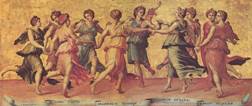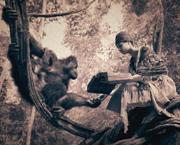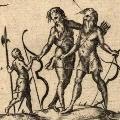Viaje de un naturalista alrededor del mundoA Naturalist's Voyage Round the WorldApril 13th, 1834.—The Beagle anchored within the mouth of the Santa Cruz. This river is situated about sixty miles south of Port St. Julian. During the last voyage Captain Stokes proceeded thirty miles up it, but then, from the want of provisions, was obliged to return. Excepting what was discovered at that time, scarcely anything was known about this large river. Captain Fitz Roy now determined to follow its course as far as time would allow. On the 18th three whale-boats started, carrying three weeks' provisions; and the party consisted of twenty-five souls—a force which would have been sufficient to have defied a host of Indians. With a strong flood-tide and a fine day we made a good run, soon drank some of the fresh water, and were at night nearly above the tidal influence.
Chapter IX
SANTA CRUZ, PATAGONIA, AND THE FALKLAND ISLANDS.
The river here assumed a size and appearance which, even at the highest point we ultimately reached, was scarcely diminished. It was generally from three to four hundred yards broad, and in the middle about seventeen feet deep. The rapidity of the current, which in its whole course runs at the rate of from four to six knots an hour, is perhaps its most remarkable feature. The water is of a fine blue colour, but with a slight milky tinge, and not so transparent as at first sight would have been expected. It flows over a bed of pebbles, like those which compose the beach and the surrounding plains. It runs in a winding course through a valley, which extends in a direct line westward. This valley varies from five to ten miles in breadth; it is bounded by step-formed terraces, which rise in most parts, one above the other, to the height of five hundred feet, and have on the opposite sides a remarkable correspondence.Viaje de un naturalista alrededor del mundo13 de abril de 1834. El Beagle echa el ancla en la desembocadura del Santa Cruz. Este río desagua en el mar a unas 60 millas al sur del puerto San Julián.
CAPÍTULO IX
El Santa Cruz, la Patagonia y las islas Falkland.
Durante su último viaje lo había remontado el capitán Stokes en una extensión de cerca de 30 millas; pero la falta de provisiones le obligó a retroceder. No se conocía de este río más que lo descubierto en la excursión de que acabo de hablar. El capitán Fitz-Roy se resuelve a penetrar todo lo que el tiempo permitiese, y partimos el 18 en tres balleneras llevando provisiones para tres semanas. Componíase nuestra expedición de 25 hombres, fuerza suficiente para desafiar a un ejército de indios. La marea ascendente nos arrastró muy pronto; el tiempo estaba bueno e hicimos una larga etapa; no tardamos en beber agua dulce del río, y por la tarde nos encontramos donde ya no se dejaba sentir la marea.
En este punto toma el río el aspecto y la anchura que conserva casi sin diferencia hasta el extremo de nuestro viaje. La anchura media es de 300 a 400 metros, y la profundidad, en el centro, 17 pies.
Uno de los caracteres más notables de este río es la constante rapidez de la corriente, que oscila entre cuatro y seis nudos por hora. El agua tiene un hermoso color azul, aunque con ligero tinte lechoso, y no es tan transparente como se cree a primera vista. Forman el lecho cantos rodados como los de las orillas y las llanuras inmediatas. Describe numerosas inflexiones en un valle que se extiende en línea recta hacia el oeste, y que tiene de cinco a diez millas de anchura; limitándolo terrazas que se elevan comúnmente por grados, unas sobre otras, hasta la altura de 500 pies, coincidiendo marcadamente en los dos lados del valle.
Charles Darwin






















































































































No hay comentarios:
Publicar un comentario